A common topic in my articles and books is how references to religion have been changed in video game localization for years and years. I thought it would be nice to finally have a central article that I can link to for reference, so I’ve started the gallery below.
This list is still very new, of course – I’m basically just getting the ball rolling for now. But I hope to expand it little by little over time, so if you know of any other examples, let me know in the comments!
There are also countless examples of when religious content was inexplicably left unchanged, but again, that’s a big topic that probably deserves its own gallery. For now, this is just meant as a big list of examples for reference and fun.
ActRaiser
In the Japanese version of ActRaiser, you play as God and are assisted by an angel in your quest to defeat Satan. During the game, you have to defeat gods from other religions in order to regain the people’s religious faith in you.
The game has religion at its very core, so to get around Nintendo’s policies, some names and terms were changed for the English release. As a result, you no longer play as “God” but as the “Master”, and “Satan” is now instead known as “Tanzra”.
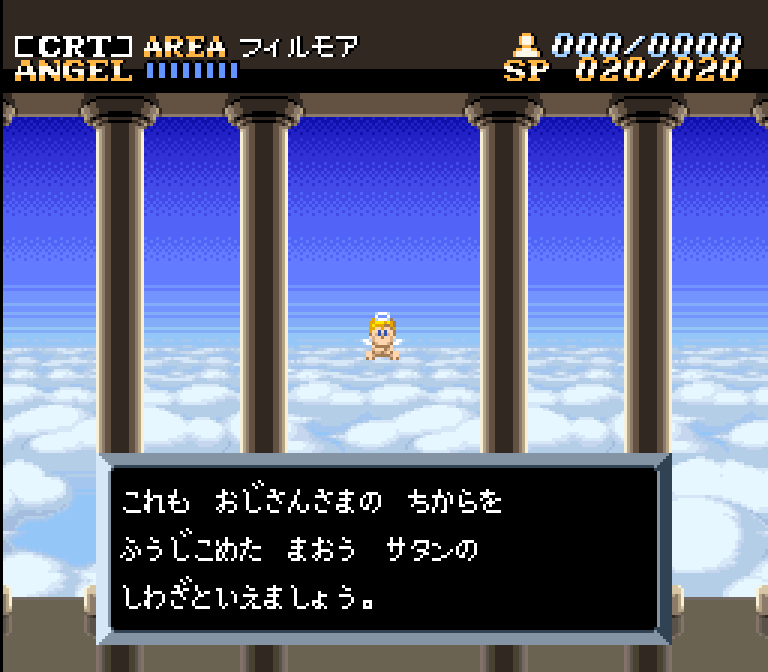 | 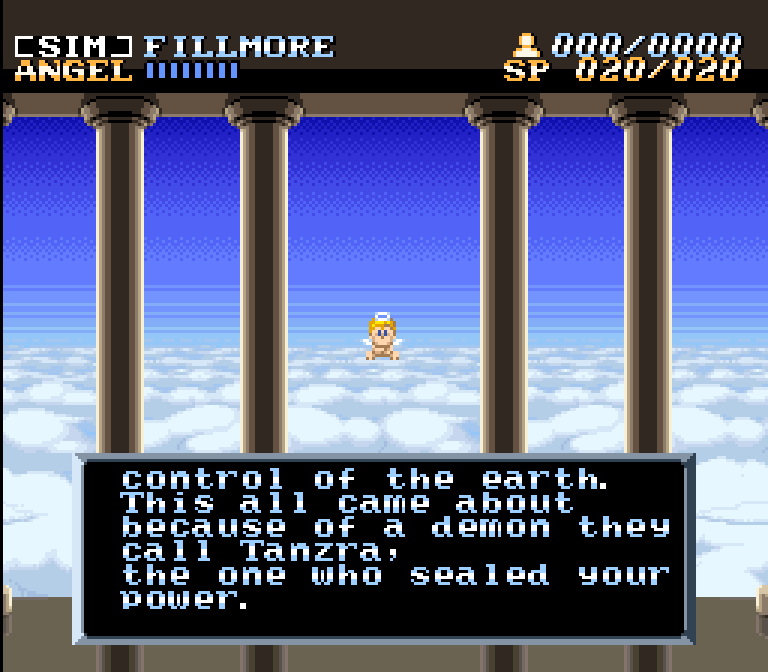 |
| ActRaiser (Super Famicom) | ActRaiser(Super NES) |
I haven’t done a detailed text comparison of Japanese and English versions of ActRaiser yet, but I look forward to doing a live Wanderbar comparison of it someday.
Bomberman II
The original Japanese game featured a cross during the story cutscenes. This cross was removed for the localized release:
 |  |
| Bomberman II (Famicom) | Bomberman II (NES) |
Dragon Warrior IV
The cross imagery in Dragon Quest IV was replaced with a pentagram/star symbol. Less obvious things were changed as well, such as the word “priest” being replaced with “shaman” everywhere. I wrote a little bit more on this subject here a few years ago.
 | 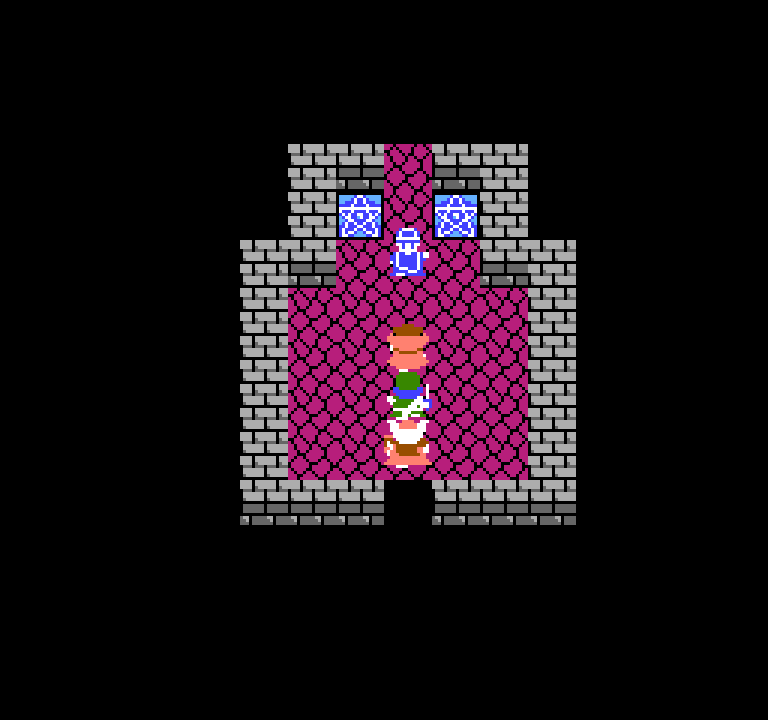 |
| Dragon Quest IV (Famicom) | Dragon Warrior IV (NES) |
EarthBound
This game featured a lot of religious content, including cults and religious concepts from different cultures around the world. There are too many changes to list here, but you can read more about them in my big EarthBound translation comparison or in my more in-depth book about EarthBound’s localization.
One good example takes place during the final battle of the game. In Japanese, Paula calls out and asks God for help. In the English version, she instead asks for help from nothing/no one in particular:
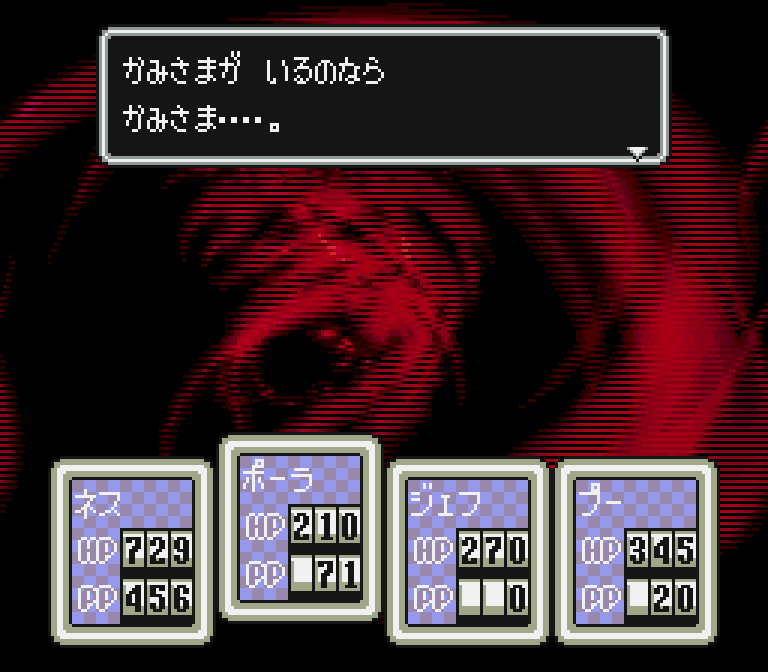 | 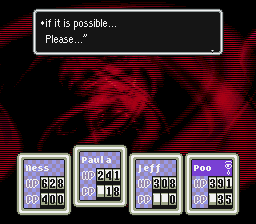 |
| MOTHER 2 (Super Famicom) | EarthBound (Super NES) |
EarthBound Beginnings
Crosses were removed and/or replaced with less symbolic images.
Here we see that the crosses in the graveyards were all altered:
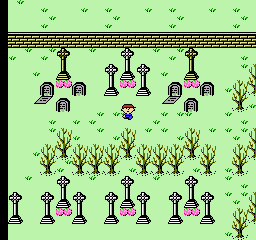 | 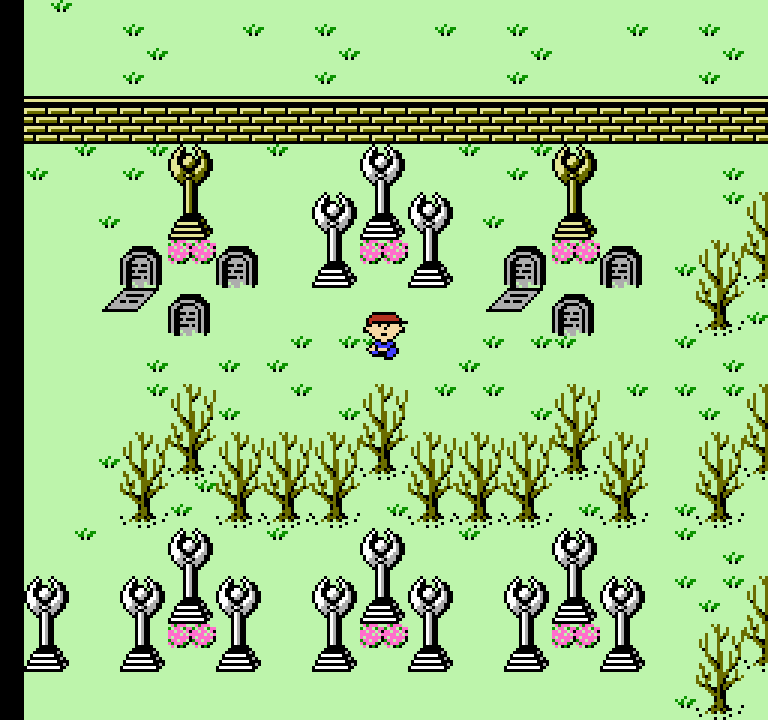 |
| MOTHER (Famicom) | EarthBound Beginnings (NES/Wii U VC) |
The tiny cross on top of the churches were removed, as were the tiny crosses on some of the gravestones:
 | 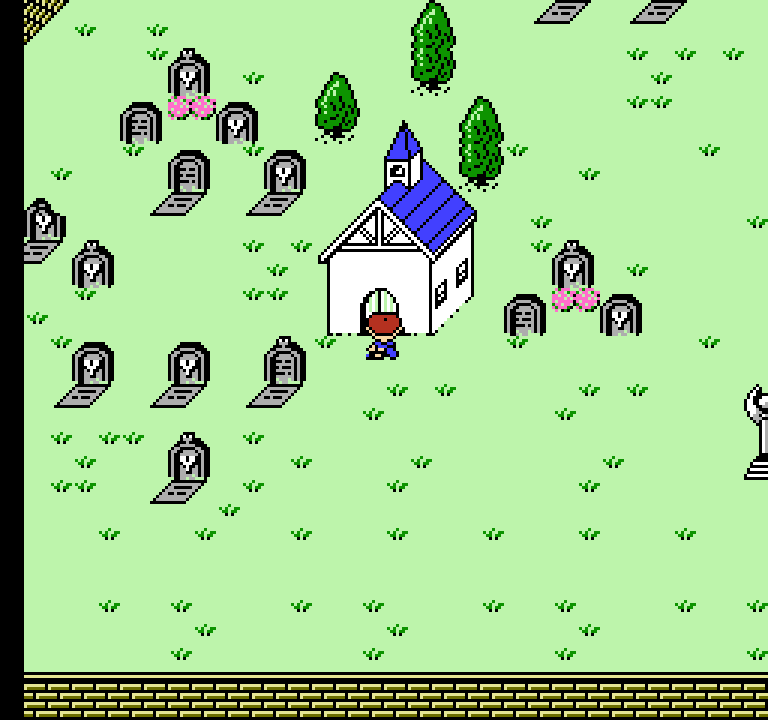 |
| MOTHER (Famicom) | EarthBound Beginnings (NES/Wii U VC) |
And the crosses inside the churches were changed into stained glass windows:
 |  |
| MOTHER (Famicom) | EarthBound Beginnings (NES/Wii U VC) |
Final Fantasy
The original Final Fantasy game had several instances of religious alterations. The most obvious ones involve the church, which was replaced with a generic “clinic”:
 |  |
| Final Fantasy (Famicom) | Final Fantasy (NES) |
And the priests in the church had their hats removed to avoid any direct religious connections:
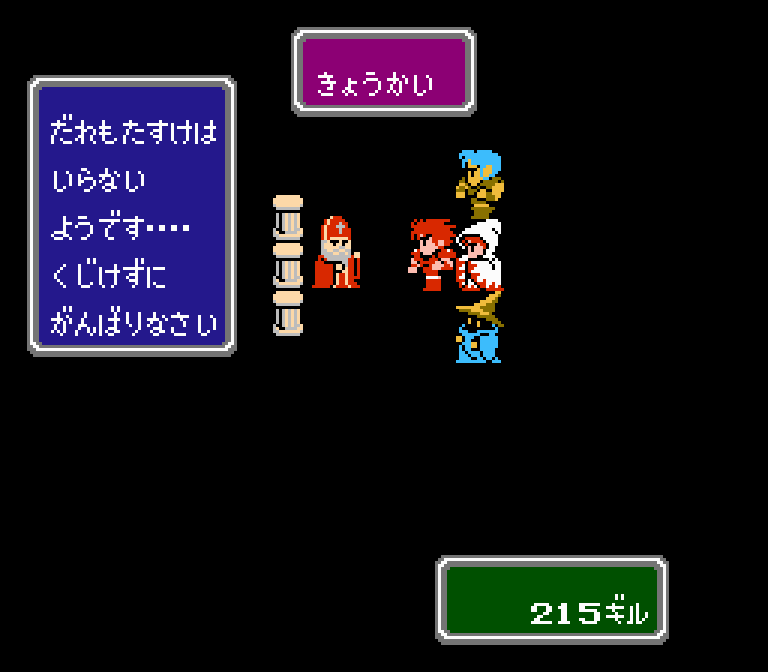 |  |
| Final Fantasy (Famicom) | Final Fantasy (NES) |
Final Fantasy IV / Final Fantasy II
Final Fantasy IV underwent countless changes during its original localization, including many changes to religion-related content. I’ve covered the game’s translation in great detail here if you’re interested. As one example, almost every reference to the word “prayer” was replaced with “wish”:
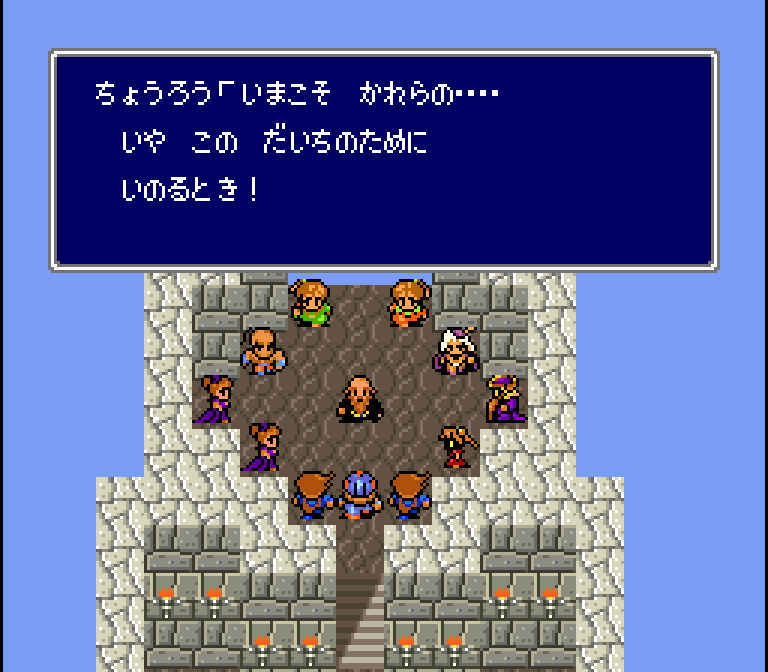 | 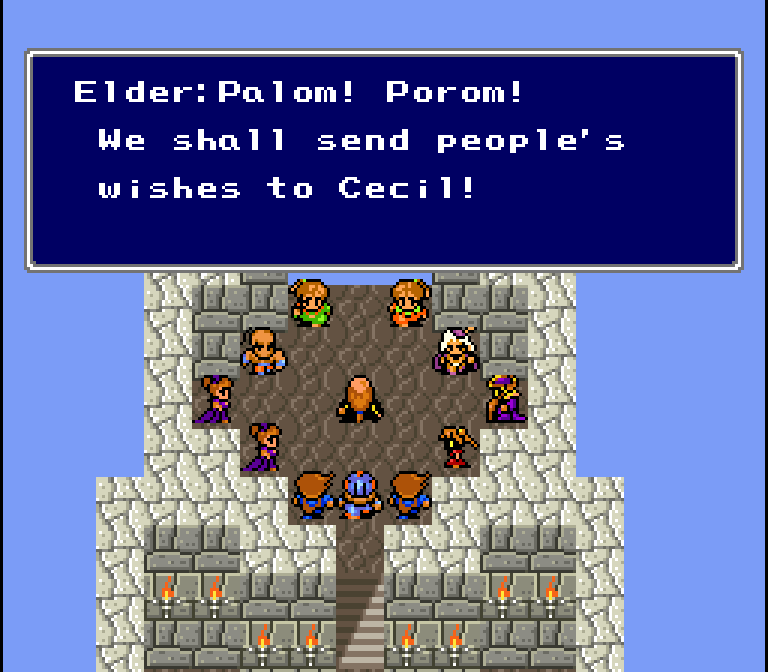 |
| Final Fantasy IV (Super Famicom) | Final Fantasy II (Super NES) |
Final Fantasy VI / Final Fantasy III
Final Fantasy VI had countless changes to religion-related content, many of which I’ve documented here. There are far too many examples to list here, so see that detailed analysis for more comparisons.
In the following example, the “Holy” spell was renamed “Pearl”:
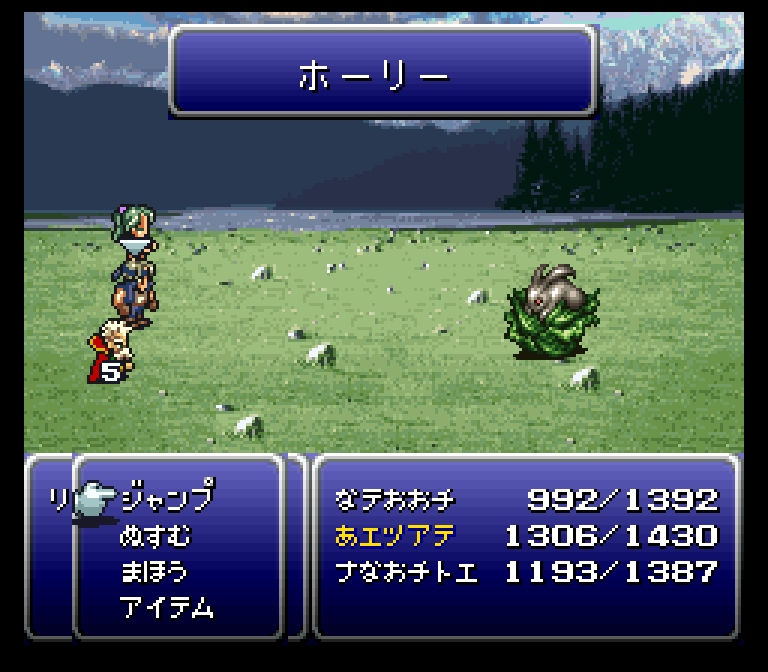 | 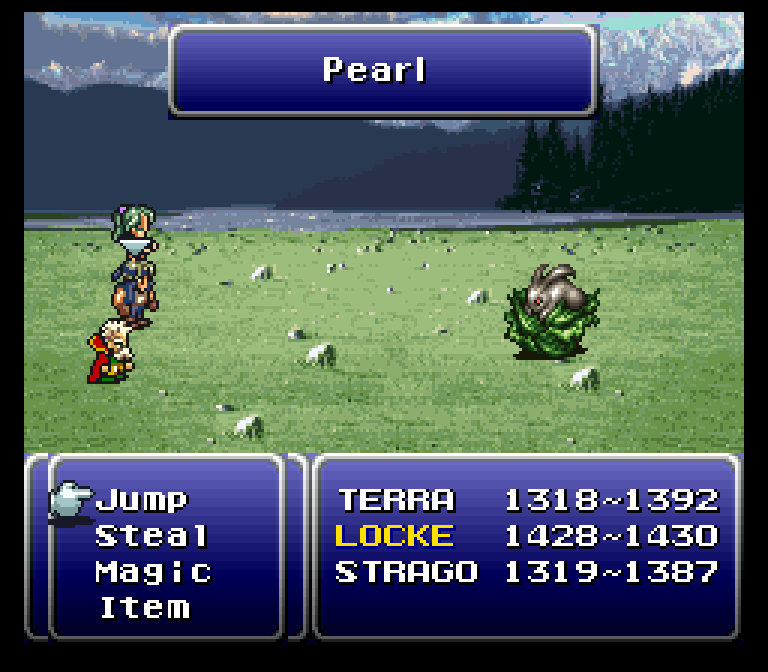 |
| Final Fantasy VI (Super Famicom) | Final Fantasy III (Super NES) |
Final Fight
This classic game underwent many changes during the localization process, mostly related to violence. There was one memorable change involving religious content, though: the phrase “Oh! My God” was changed to “Oh! My Car”.
 |  |
| Final Fight (Super Famicom) | Final Fight (Super NES) |
The Legend of Zelda
The “Bible” item in the original Japanese game was changed into the “Book of Magic” for the English localization. This is a very intriguing change this early in Nintendo of America’s history, especially given the inclusion of crosses in the game and the improvement of cross imagery in the sequel’s localization.
If you’re interested, I cover this and religious content changes in a little more detail in my in-depth book about Zelda 1’s English localization.
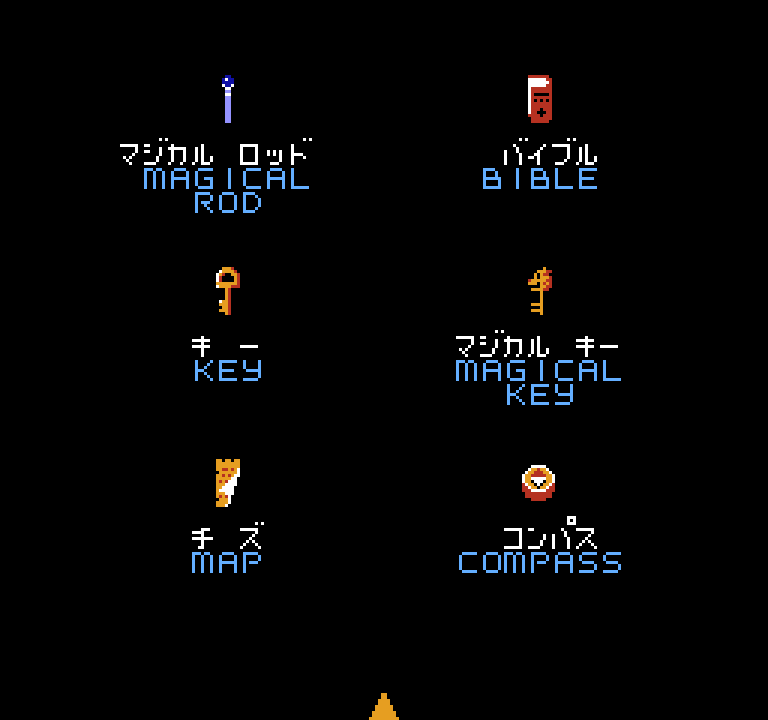 | 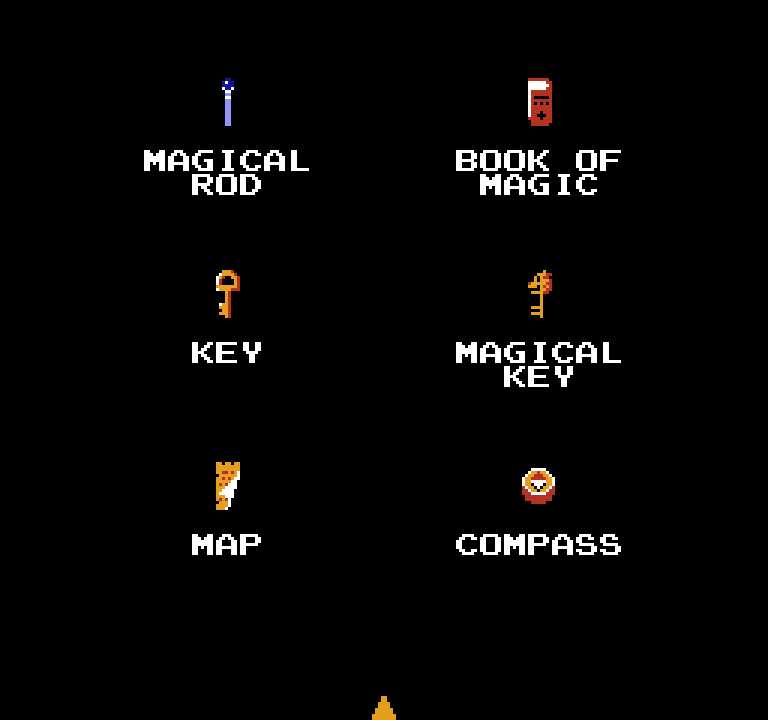 |
| Legend of Zelda (Famicom Disk System) | The Legend of Zelda (NES) |
Lufia II: Rise of the Sinistrals
Gods are a prominent topic in this Japanese RPG series. Due to Nintendo’s policies at the time, “gods” was replaced with “super beings” in the English release of the second game.
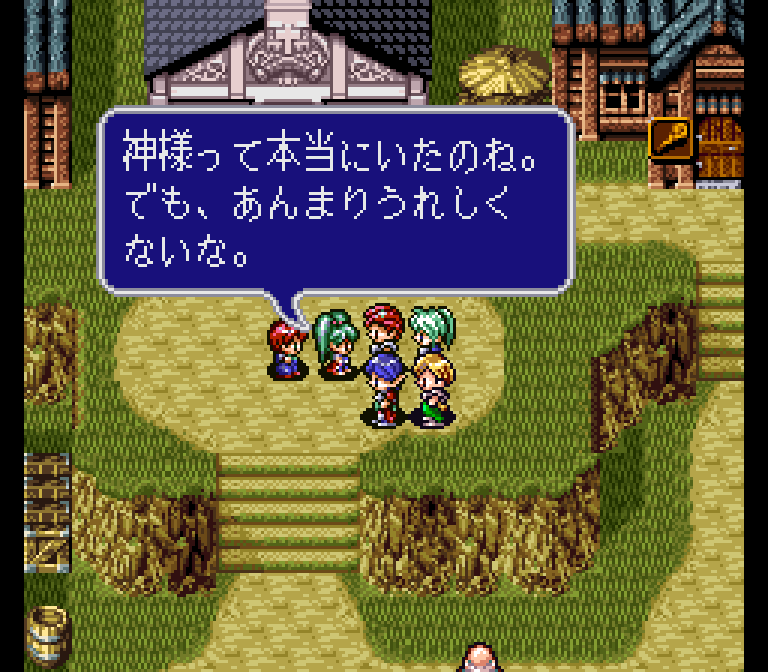 |  |
| Estpolis Denki II (Super Famicom) | Lufia II: Rise of the Sinistrals (NES) |
This terminology change becomes especially awkward later in the game’s translation, with quotes like this:
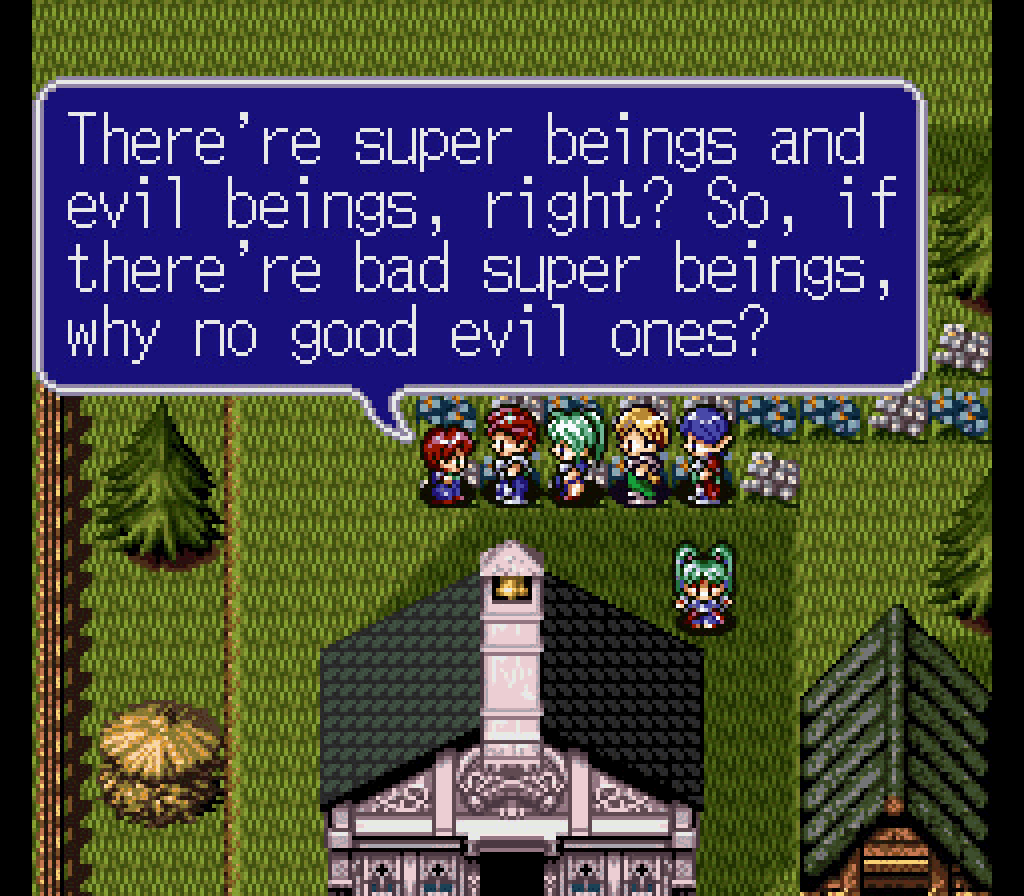
The English release underwent other religious content changes too, such as the word “pray” being replaced with “wish” everywhere.
Star Ocean: The Second Story
I believe a number of religious changes were made for this game’s localization, but the big one that I remember has to do with a special attack that originally featured the image of a crucified figure. The localized version changed it into a more generic angel instead:
 | 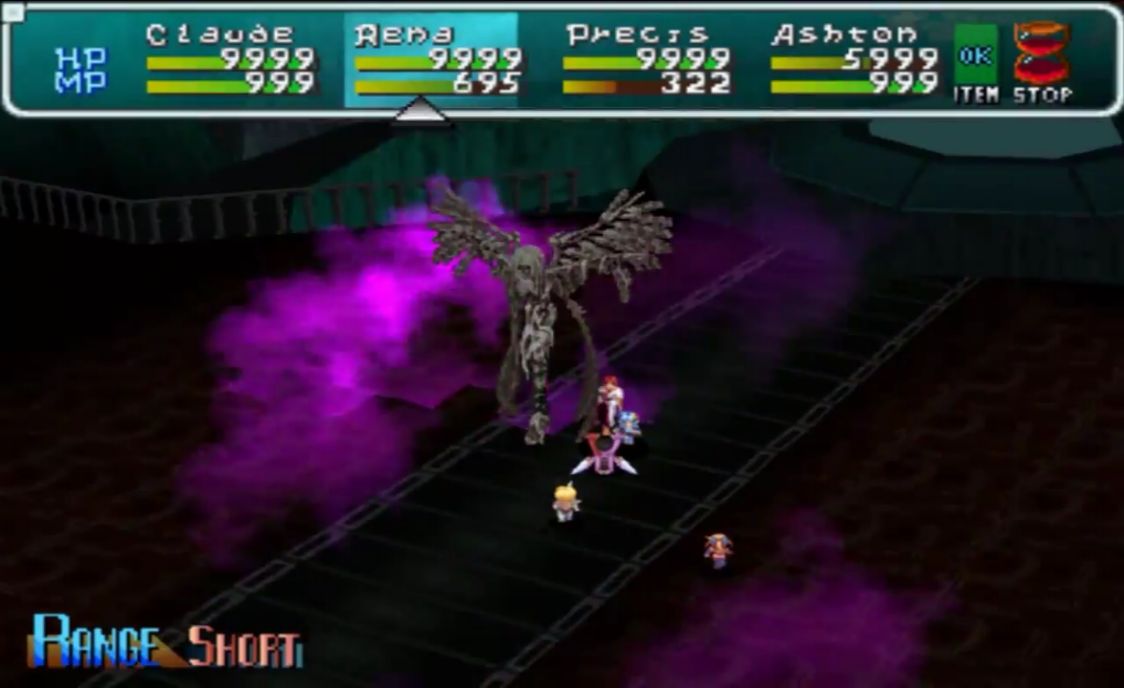 |
| Star Ocean: The Second Story (Japanese PS1) | Star Ocean: The Second Story (North American PS1) |
I believe there was also a spell that displayed a giant cross in the Japanese version, which was replaced with a pillar in the localized version.
Super Castlevania IV
This game received a number of localization changes, but I haven’t looked too deeply into them myself yet. The changes are apparent as soon as you turn the game on, though: the grave in the intro scene had its cross removed for the localized release, as well as the “Dracura” text that stemmed from the infamous L/R problem in Japanese translation. Even the little crosses in the background were all removed:
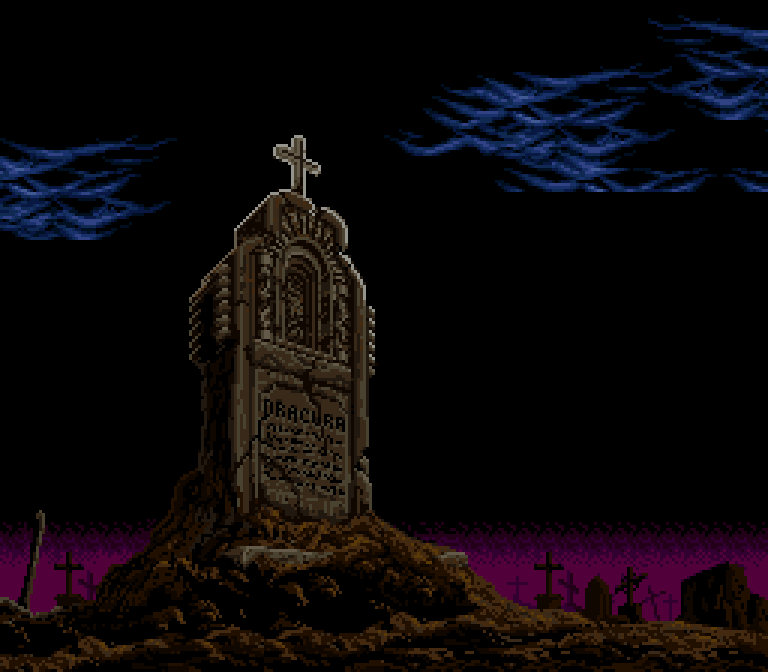 | 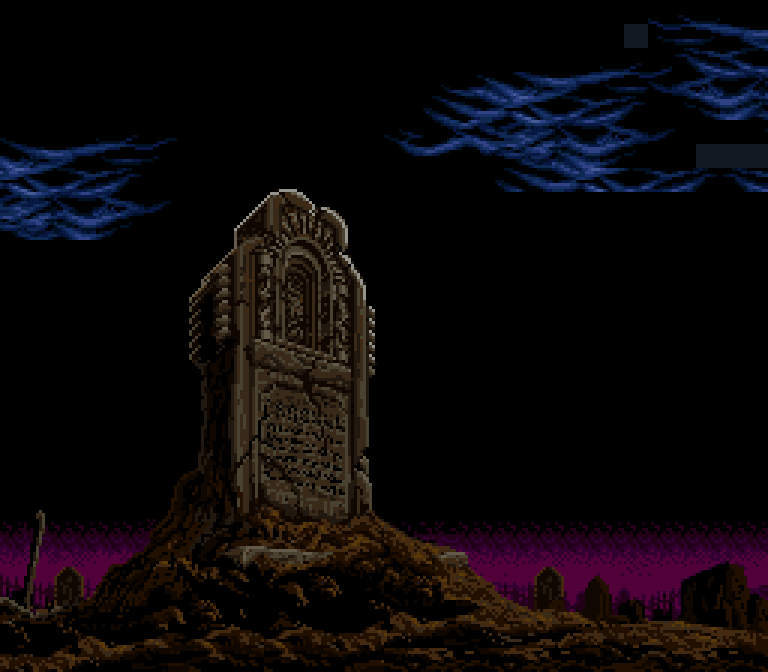 |
| Akumajō Dracula (Super Famicom) | Super Castlevania IV (Super NES) |
Um Jammer Lammy
The hell-themed level in the Japanese version of this game was replaced with a completely new level that takes place on a volcanic island:
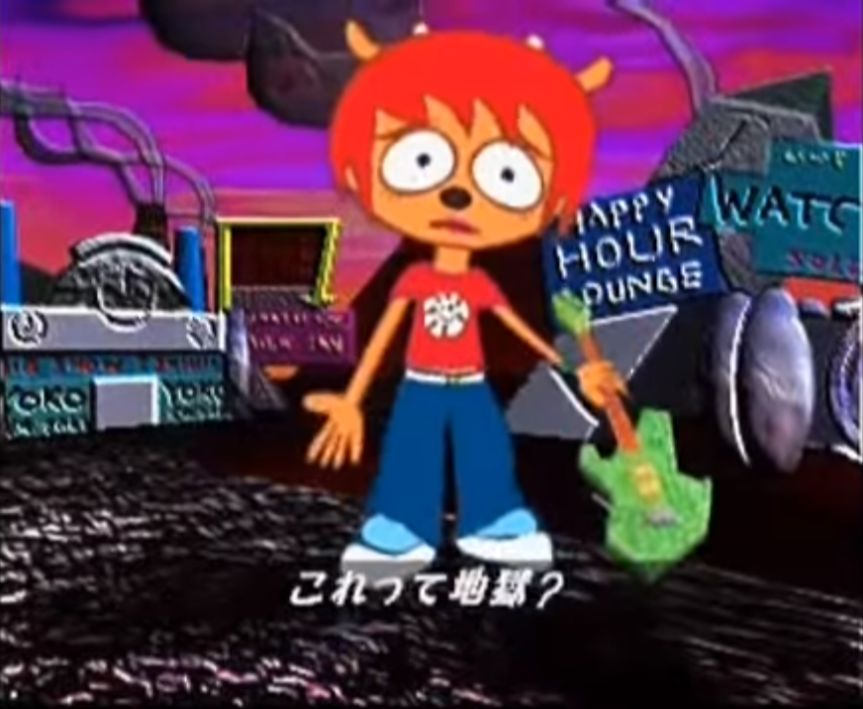 | 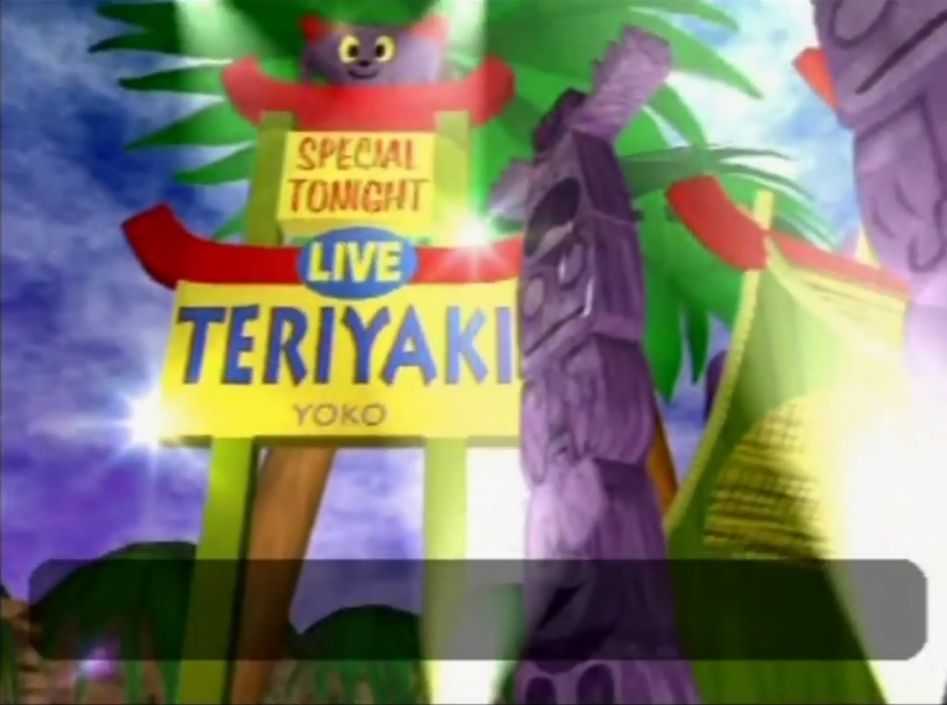 |
| Um Jammer Lammy (Japanese PS1) | Um Jammer Lammy (North American PS1) |
So Many More
Again, this list is still very new and incredibly incomplete. My goal is to update it from time to time with more examples from as many video game localizations as I can, so if you know of any examples, let me know in the comments. It especially helps if you can provide images or videos, but isn’t necessary.
As we can already see, religious content in video games has been a touchy topic for game publishers for decades now. My hope is that we’ll learn and discover a lot by seeing how specific examples were handled by each publisher over time. And it’s also just a fun topic to look at!
If you enjoy this kind of look at video game localization changes, check out my article about Nintendo of America's content policies in the 1990s too. It even touches on some of the reasons for these religious content changes too!


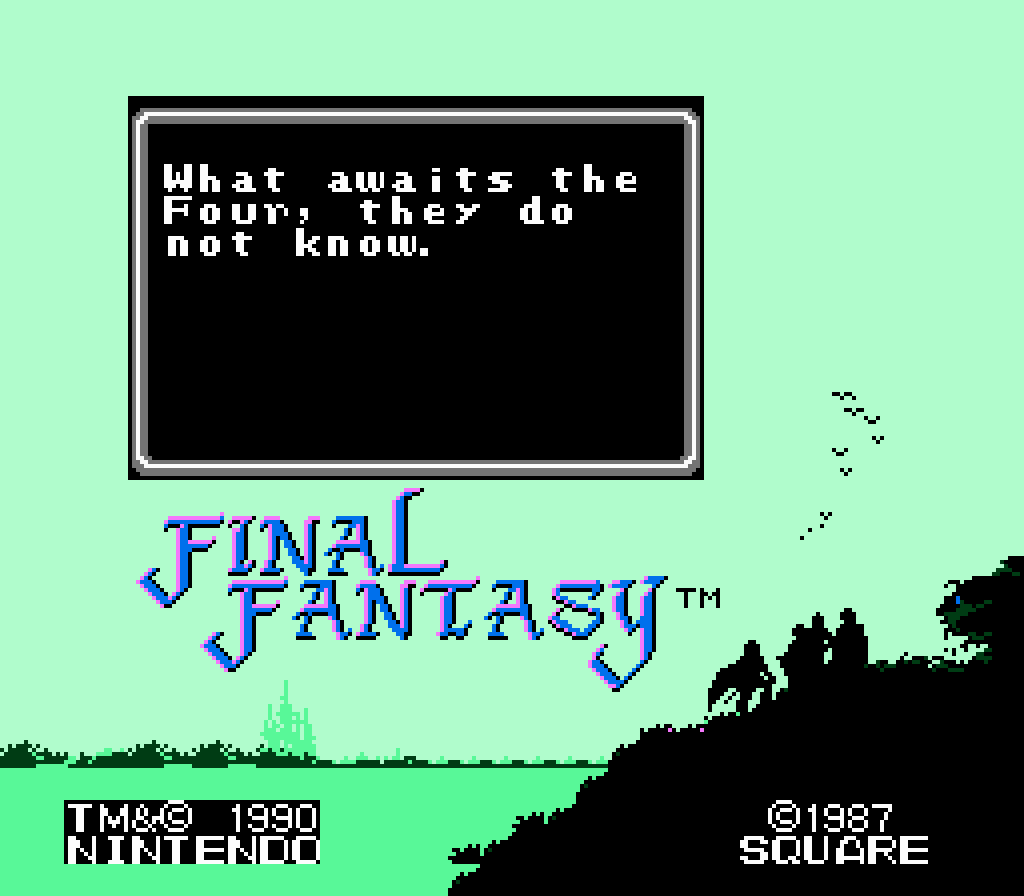
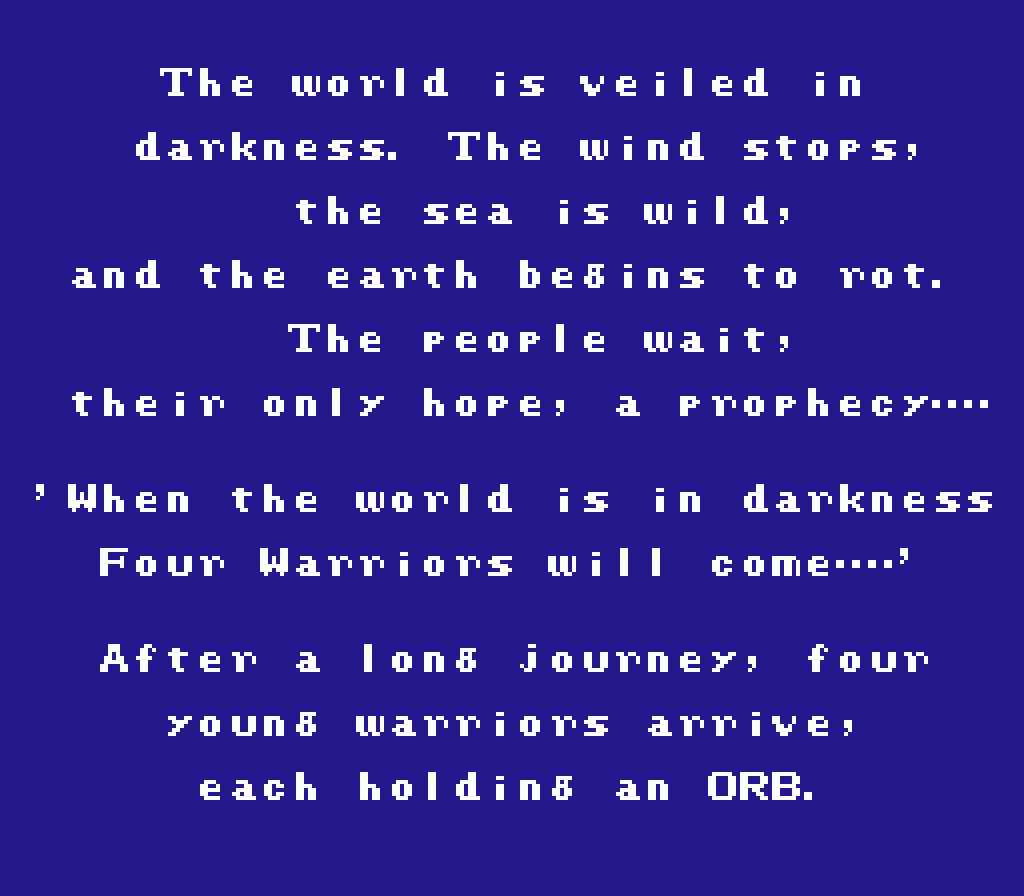
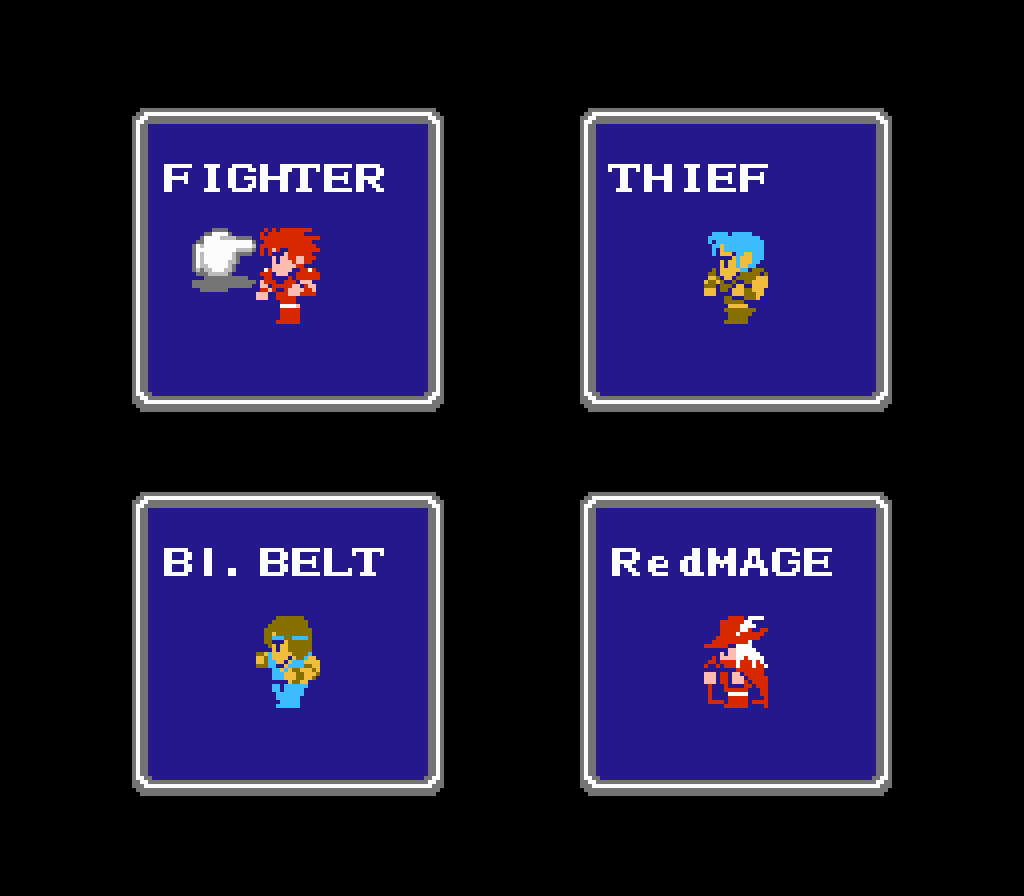
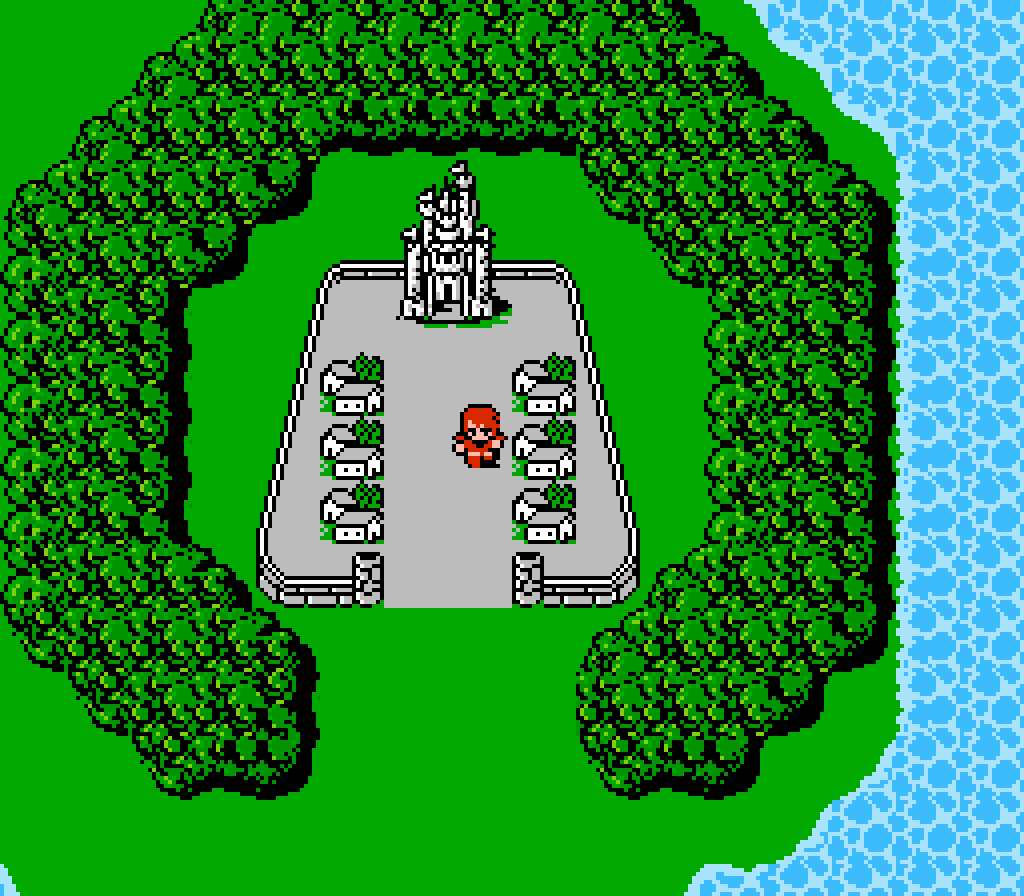
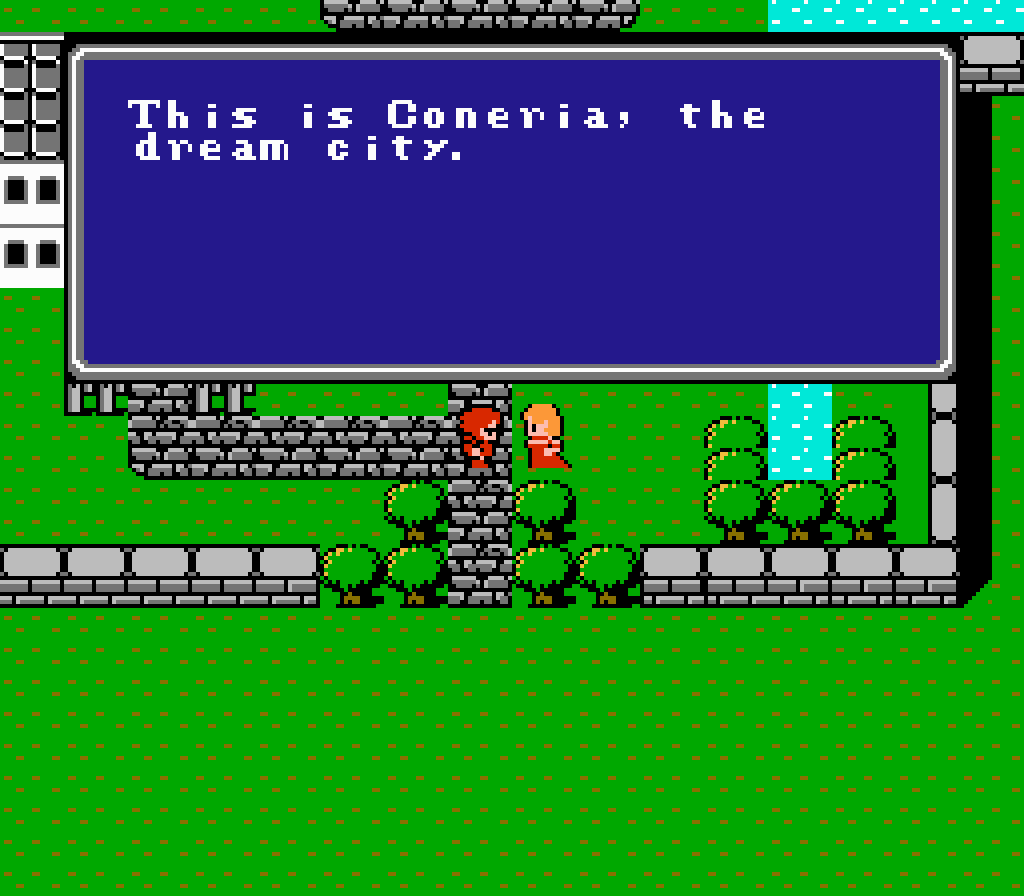

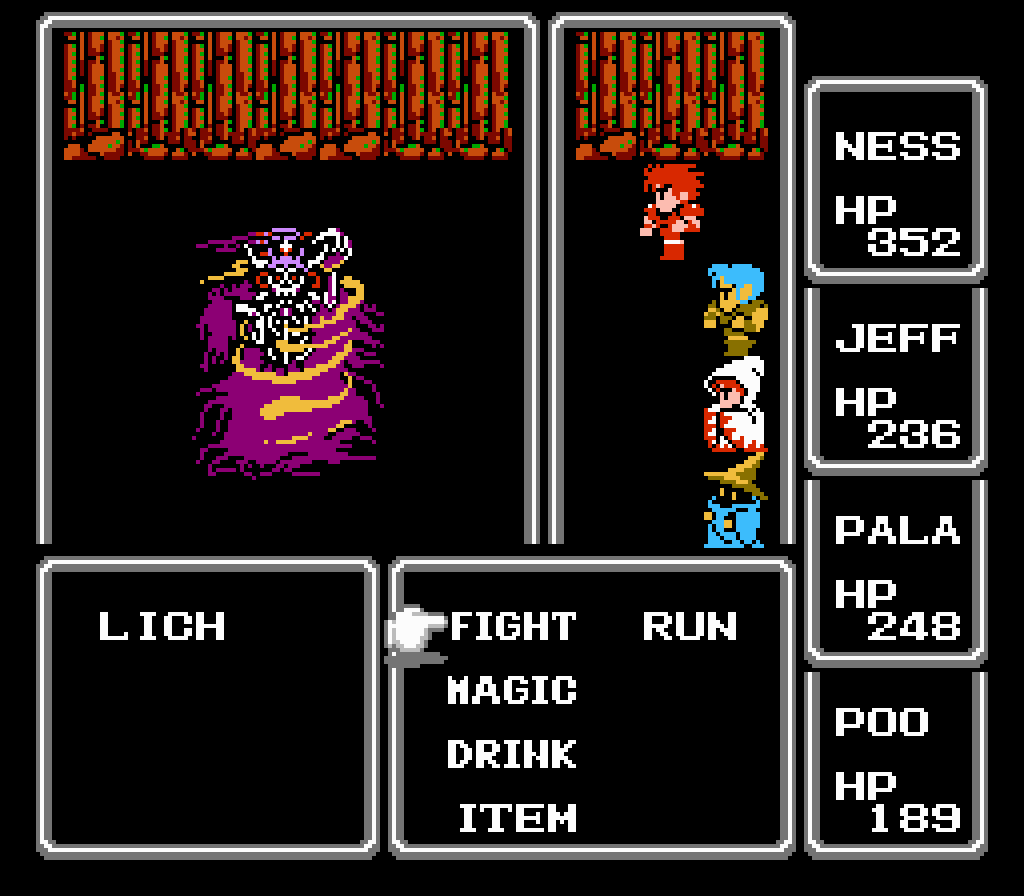

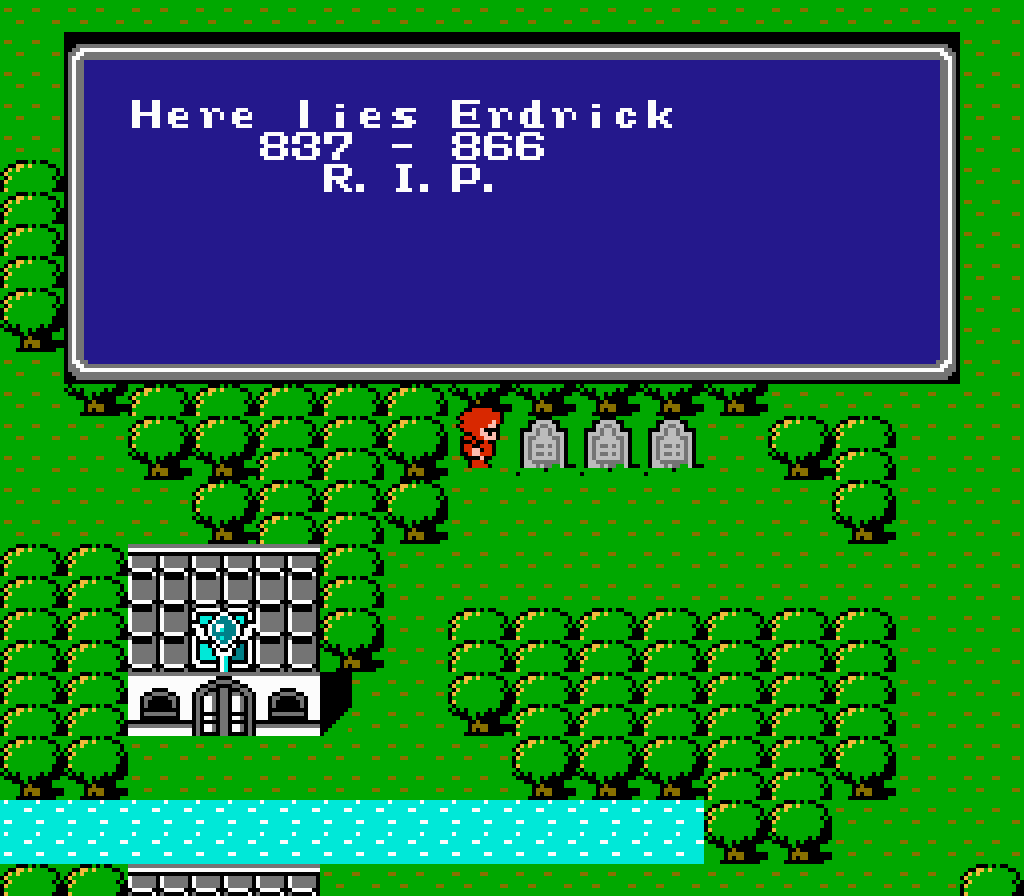
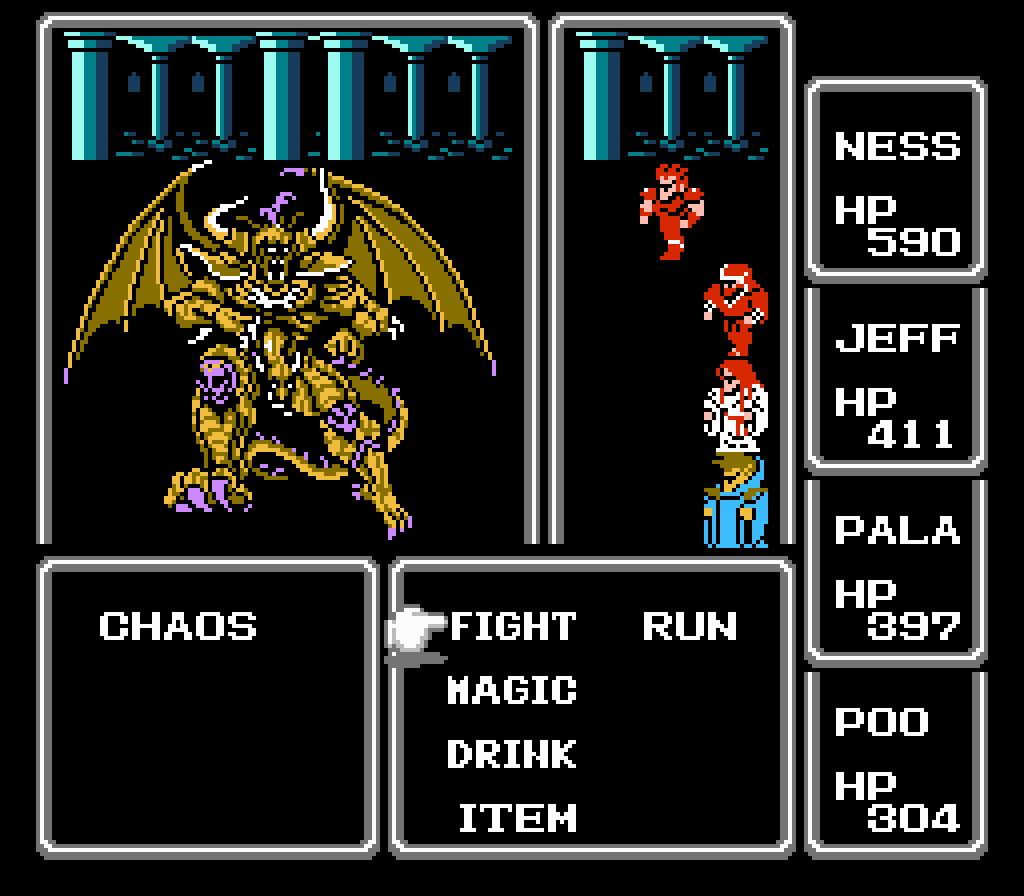
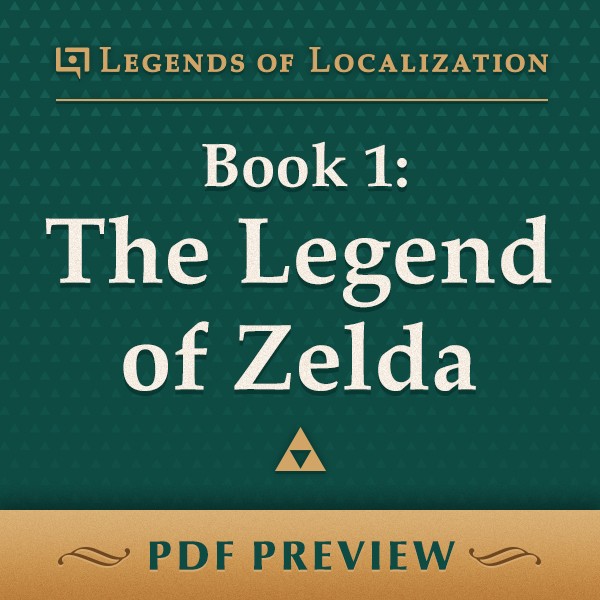
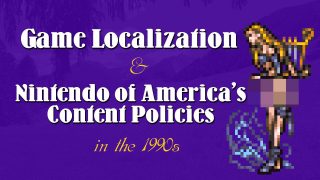
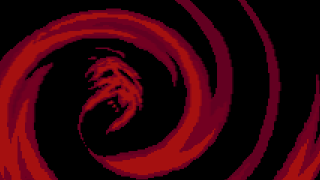

Thanks for the interesting article, Tomato! I always learn a lot from your writing.
Is there any connection between the Japanese names for the recurring Blue Magic spell / enemy skill White Wind and the spell/element Holy? I ask because White Wind was translated as Pearl Wind in the SNES version of FFVI.
“White Wind” and “Holy” have those names in the original releases (English words in katakana)
Interesting, thanks!
Over the years I’ve always thought that naming it “Pearl” was a reference to the pearly gates, to keep that holy feeling without being explicit.
In Castlevania IV they remove the cross itself. In Castlevania III they remove some irrelevant garnishes around the cross, arguably making the cross itself more pronounced, ironically. Also in Castlevania IV they cover up background statues but leave Medusa naked. These policies sure are consistent!
I was under the impression that Castlevania III’s big cross change wasn’t for religious iconography reasons, but due to being reworked for a different “mapper” than the japanese release used. But it looks like the MMC5 has a direct VRC6-compatible banking mode, and both games use same-size ROMs. The only thing it seems MMC5 can’t do is VRC-style interrupts, but that shouldn’t matter AT ALL for the cross.
Maybe they thought the rays were a bridge too far, implying it was a cross imbued with THE LORD’S HOLY MAGIC instead of your garden-variety torture implement. But booting crosses out of a friggin’ VAMPIRE game always struck me as pretty WTF anyways.
The “no religion” rules were the most spottily-enforced back in the day, because it was a lot harder to make a solid A-or-B test, so it wound up just being whoever was involved’s judgement call. The “crosses on tombstones” thing is exceptionally funny to me, since both NES Zelda games heavily featured crosses on tombstones.
…
Actually, replacing crosses with pentagrams in Dragon Warrior 4 is ALSO funny to me.
I considered mapper incompatibilities, but, from what I understand, MMC5 was designed specifically to handle VRC6/Castlevania III (minus the sound). Also, it’d just be some more CHR tile data, probably. While we’re at it, they never even bothered censoring the rosary/cross item in these games, the thing that wipes enemies from the screen. Not only is it religious iconography, it actually does something divine.
I, too, thought the Dragon Warrior pentagrams were funny. That’s arguably more offensive than the crosses.
Baten Kaitos Origins has one, a crucifix removal.
Note that here, the crucifix has a certain symbolism. At the end of this scene, Sagi gets his strongest Special Attack- The Apotheosis. Apotheosis means “to become a god”, and while in Christianity Jesus always was God, the crucifixion does elevate him out of the mortal existence he had taken on. And although Sagi lives, the crucifixion scene does mark the ascent of him into his full powers.
https://tcrf.net/Baten_Kaitos_Origins
Forgot to add there was another BKO change, as mentioned at the end of that article- Chaotic Dance 2 was partly redone to remove lyrics, really just scat vocals, which sounded like “praise the lord”.
And LoZ: A Link to the Past also had its changes as you likely well know, but I’m just reminding you. The subtitle Triforce of the Gods became A Link to the Past, the Church in Japan became a “Sanctuary”, its Priest a “Loyal Sage”.
Also, in Pokemon, the original Japanese Red and Green Alakazam design had a hexagram on it, not sure if it was intended to be a religious reference or not. But no future Alakazam designs in Japan or aboard used it.
https://cdn.bulbagarden.net/upload/8/85/Spr_1g_065.png
Also, Aghanim or whatever his name was was also a priest in the original. Oh, and then there’s the whole kneeling and praying thing to open the desert temple.
It is worth noting that some of these changes varied across the game’s different regional English localizations. For example, Um Jammer Lammy’s Hell stage was censored/changed for the North American version only – The stage 6 setting for the version sold in Europe is the same as the one for Japan. The localized script was also changed to reflect this.
I played through Zelda 3 in Japanese a couple months ago, and while I wasn’t exactly sitting there with the English script open and comparing the two, I remembered roughly how a lot of lines had been translated into English, and it was extremely obvious the English translator had been given a very specific list of Really Bad Words That Must Not Appear In The Translation, these words being at the very least “god”, “priest”, “church”, “holy/sacred”, “pray/prayer” and even “temple”.
Makes you wonder how Ocarina of Time’s English script would’ve turned out had these words been forbidden there as well.
Oh, and Zelda 2 very consistently censors “shinden” (temple) to “palace” as well. OoT was the first game in the series where the word was translated straight.
This is something I was completely unaware of. How is it that a country with a less than 1% Christian population uses Christian imagery, yet all of this MUST be removed from the Western bastardization of the game ’cause “reasons.”
It’s never been Christian imagery SPECIFICALLY; the only reason the majority of examples are Christian is because for various reasons that’s the most commonly referenced religion in the first place.
Nintendo’s policy may have strangely exempted pentagrams, but on other systems Working Designs removed both pentagrams and hexagrams from the Lunar games on Sega CD (while leaving the one cross intact), as have video games based on the Yu-Gi-Oh franchise.
Final Fantasy VI/III changed at least one Islamic reference (Jihad…changed to Crusader, so actually adding a Christian reference), and at least two Buddhist ones (Majin and Kishin, changed to Doom and Poltergeist).
Pokemon Gold and Silver (but not the remakes) removed the Buddhist prayer beads from the Mediums and changed the hands of the Sages (Buddhist monks) so they aren’t praying, in addition to both classes’ English names having less religious connotations than their Japanese ones.
Nice, this was very interesting! To give you some more examples: the whole intro/all cutscenes of ‘Karnov’ were removed from the Western release, due to them being based around religion/God sending Karnov on an errand. ActRaiser had some references to God etc. removed; same with Crystalis.
Crystalis is called God Slayer in Japan, although the game itself had little to do with slaying gods
In the Korean version of Pokemon HeartGold and SoulSilver, a trainer class had their robes changed because they looked like monks. I think they’re the one commonly found in the Sprout Tower? I read this on Bulbapedia years ago, so I can’t remember some details.
I think part of the reason why the sages had their robes changed in the Korean version can be traced to Korea’s history and current sociopolitical stature in East Asia. From 1910 to 1945, Korea was under Japanese occupation, with the Japanese colonizers forcing the population to assimilate into Japanese culture through official legislation; Koreans were legally required to take up Japanese names, learn and use Japanese in public, and in general avoid any major display of Korean culture.
After Japan lost World War II and, consequently, its control over Korea, Korea went through a gigantic backlash against all things Japanese, among other things banning the vast majority of Japanese cultural imports from 1945 to 2004 (this is also why Nintendo and Sega consoles were sold under completely different names in South Korea; they had to be licensed to and sold under Korean brands in order to be made legally available in the nation). Huge social and political tensions also formed between Japanese and Korean people in both Japan and Korea, as illustrated by the recently reignited controversy over Japanese acknowledgement (or lack thereof) of “comfort women.”
It’s either these sociopolitical tensions or the lingering elements of the cultural ban that led to the sages’ sprites being altered to look more culturally “Korean.”
One surprisingly late instance of this is Golden Sun. The Wise One isn’t just Vale’s protector, he’s their god. This gets really clumsy at the top of the Mercury light house. First a Mary asks if the main character is a priest from Sol Temple (He’s from there, but not a priest) becomes asking “Mia” (I’ve got no idea why they changed the names that fit within the character limit already) if he’s a “healer” from “Sol Sanctum” which is weird because he IS a healer.
This is shortly followed by Mary addressing her dead father, explicitly stating so, and asking forgiveness for her failure while looking to the sky. In English she just mops and says she failed her duty.
The second throws this out entirely and freely mentions gods and goddess.
People tend to react badly to this sort of thing in a bit of a knee-jerk way, but not every one of these is terrible. Let’s be real, the idea of using the Bible to throw fireballs makes very little sense to a westerner
This is certainly true. And people can complain all day about censorship in Crystalis extending as far as the title, but… no. You couldn’t sell a game called “God Slayer” in America in the 80s, when we were still afraid of D&D causing satanism. It wouldn’t even get STOCKED in most stores, you don’t even have to worry if people will buy it.
(My favorite censorship complaint is still the cider in FF3. Sake would’ve gone down with “spoony bard” as silly randomness, because children in the early 90s were surprisingly uninformed about japanese alcoholic beverages. And even better, hard cider is a thing. So Woolsey actually DID get an alcohol reference past Nintendo’s censors, like a boss. The man deserves a medal.)
I think it’s worth noting that people aren’t necessarily angry about the censorship ITSELF, but the fact that the American culture at the time was one where you pretty much had to censor stuff like this out because crazy people would arrange literal protest marches if you didn’t.
Doesn’t help that this censorship made it to Europe as well, which didn’t have this culture (it had its own nonsense, yes, but that generally didn’t affect America).
It wouldn’t have been a protest issue. The game literally never would’ve made it far enough for anyone to become aware of its existence.
Honestly, most of the complaints are a kneejerk “how dare Nintendo tamper with our holy japanese original content” response, and largely from the same people that think names need to include honorifics, and who think the US version is always censored even when talking about games where the japanese release was toned down.
These same people blow small changes entirely out of proportion, and miss the places where meaningful changes happened in favor of complaining about an isolated word here or a cross tile there. Heck, they even get mad over terminology changes that were made to ensure the original intent carries through.
…
In short: everyone complains about Crystalis, but nobody complains about The Krion Conquest.
Also, Crystalis is a BETTER NAME than God Slayer, especially as there isn’t actually any god-slaying present in the game and the title sword is used exclusively to destroy a computer. I am going to claim the western title as an objective improvement.
The actual in-game translation is fine, but certain people are all “OMG THEY CHANGED THE NAME THOSE FASCISTS!” because they feel an impulsive need to complain.
Well, Japanophiles and weebs are cancer in the end. Their reactionary behavior does not surprise me in the least. They don’t seem to realize that we don’t use honorifics in English the way the Japanese do for literally every type of person. These same idiots seem to think Japanese is the mother language in North America; they’re beyond saving.
Likewise, I think removing the cross imagery from games set in fantasy universes is a good idea for localization purposes. Maybe to Japanese people, the crosses just invoke, “this is a place of worship” (or something along those lines? I’m not sure). But to Westerners, seeing churches adorned with crosses in these settings would raise weird questions like, “Do Hylians believe in Jesus?” and “Why is the priest of this apparently Christian church a polytheist?”
Oh, since you do say “changes” instead of “removal”, I assume you also want the rare examples of it being added?
In Chrono Trigger, the three Gurus were renamed in English after the traditional names of the Three Wise Men/Magi; Melchior, Gaspar, and Balthazar. The Mammon machine wasn’t called that in Japanese either.
And more randomly, two of Crono’s weapons were renamed after Hindu gods.
Speaking of Hinduism and added references…well, changing the (admittedly generic) term 賢者 to “guru” (but losing a philosopher’s stone reference in the process).
It is sad how U.S. game companies were afraid of the backlash from Christian parents in those days. The Japanese only used such imagery because they either thought it was cool or it fit within context. I’ve had Japanese pen pals tell me in the past that Christianity sounded like an “arrogant bully religion” to them, what with how they saw preachers on street corners telling people passing by that they would go to Hell if they didn’t believe in their interpretation of God.
What most pearl-clutching parents and Bible thumpers from those days failed to understand is that use of such imagery was simply an aesthetic that fit with the themes in those games. Of course, the 80s and 90s were also full of paranoid people who believed “foreign influences” would corrupt America’s youth with strange ideas and the marginalization of Christianity, which has never been any nation’s intention. Regardless, this nauseating attitude affected numerous video games for many years, as well as some other forms of media.
The most interesting thing is that in many cases, the whole thing was probably a cultural misunderstanding. Can you imagine how US Christian conservative talking-head types today would react to the idea of videogames “censoring” crosses on gravestones and churches?
Hmm, that’s a valid point you make, and you’re absolutely right. They would likely find that offensive, thinking companies are trying to excise Christian symbols in media. Me, I don’t have anything against such things. Holy spells that use crosses have some of the best visual graphics in RPGs.
> I’ve had Japanese pen pals tell me in the past that Christianity sounded like an “arrogant bully religion”
well, they’re not wrong…
I’m surprised to see a response to my original post months after the fact. And I feel that way too personally, at least in regards to extreme cases of it.
I can name another NES example. The coffins in Transylvania originally had crosses on them in the prototype for DuckTales, but this was changed to RIP in the final release (along with a host of other changes that were big improvements). The Japanese were required by Disney to also have the change in their version, so that was one case where they had to comply.
And to add to one of your list’s points, you’re thinking of the Cure All spell in Star Ocean 2.
One thing I don’t think I saw noted on this article or in the comments is that the priests in EarthBound Beginnings had their sprites altered as well; they had a visible crucifix necklace on their front-facing sprite in the 1989 version, but from the 1990 localization onwards, the cross is replaced with a generic rosary.
Regarding Um Jammer Lammy: they only changed the cutscene that plays before and after the “hell” level, and the European version still has the original Japanese cutscene. The first level also has a thing where it foreshadows the entire game so they changed that as well.
To be honest I think they changed it because it was too mean, the original first level has a lyric that says “You can play in hell! You come far!”, in stage 6 Lammy actually dies and goes to hell, after the stage is complete she’s resurrected. Compare that to the US version where stage 1 says “You can play in an island! You come far!”, in stage 6 she gets launched to an island thanks to her own clumsiness, afterwards she magically appears back where she was launched.
While less a religious reference and more a FF one, Kingdom Hearts II (English translation) called Mickey’s version of the Holy spell “Pearl” and Minnie’s version “Faith” (the latter was carried onward to later games whenever it’s a PC spell, but they’re all consistently ホーリー in JP). No idea why, as both Chain of Memories and its remake calls it “Holy” in English!
(And it’s not like the series is a stranger to religious refs, in fact they’ve become really blatant in the more recent games.)
The bizarre thing is there’s two camps on this sort of thing. There’s a group that believe this was censored to avoid offending those of other religions, however I think there was a very different reason, having grown up in the era of the Satanic Panic back in the 80’s.
Back then, a lot of major religious figures didn’t like their faith being “trivially represented” or used as nothing more than garnish in movies, comics, and computer games. I recall a number of screeds about how using crosses and stuff like that in stuff like Dungeons and Dragons was just the devil’s way of “normalizing” evil witchcraft and a pagan agenda. So, if in a vampire movie a cross was used to kill the prince of darkness, they would say all this does is glorify evil since Jesus wasn’t even mentioned by name, just a random relic used to defeat evil with no explanation, and it was a man that did it, not god personally stepping on him like a roach (or I guess a mosquito would be more appropriate).
Yes, it’s a pretty silly thing to get so bent out of shape about, but it was all over the place, as well as screeds about how Santa was evil, and presents were materialism run amok (stuff like how mall santas should go away and stores need to stop “dressing themselves up” around the holidays. This also applies to why they considered Doom evil, they had a huge problem with violence in media back in those days and complained about glorifying the military and war. Doom not only appropriated demons and made them front and center, it reveled in violence and celebrated the military. Look, of course they were overreacting and controlling, but I’ll give them this. At least there’s more of a purity of intent behind such propaganda compared to today, when it seems like the newer crop of religious figureheads were bought and paid for by the stores and have utterly violated their previous ideals regarding violence and war.
In the end, that major shift in attitude from “this trivializes our faith!” to “if you don’t stick a cross on the wall this game is an abomination” is why Nintendo of America and many others just don’t care about removing iconography like that any more. Japan didn’t get the memo though, so modern remakes of past games that got that treatment tend to keep the changes. Well, I’ll say this, at least it feels more immersive to have a wholly original faith inside these fantasy worlds, well except for Castlevania. That’s gotta have the Christian stuff in it, it’s a big part of the mythos.
Now, when it comes to OTHER faiths and things like the Muslim chanting in Ocarina of time? Yeah, the whole “this trivializes our faith” thing still applies, and they’re still careful about that to this day. Also, Christians would still
Funny thing is, NOA never did a thing about the giant cross on Link’s shield in Zelda 1, although the supposed “magical sword and shield” in Soul Calibur 2 were changed so significantly they don’t even resemble the Zelda 1 and 2 originals. Oh! I suppose that would go on the list of a late-era example of this sort of censorship.
“Also, Christians would still” what?
Thanks for the detailed explanation! As a non-American I’ve been utterly confused by this for years, asking myself “but why would they refuse representation of their religion in games when it’s usually shown to be on the good guys’ side?”. Now add to this, as was said elsewhere on this website, that editors wouldn’t run the risk of having to submit their games to NOA more than once, so a limited but loud group of people was all it took to have them be overly cautious.
Wasn’t aware of the recent developments in the opposite direction, either. This sure doesn’t sound fun…
My favorite is Lufia II: Rise of the Sinistrals for SNES, where I’ve read that it was the censorship of a cross graphic that mangled a sprite set and made one temple area into incoherent graphical garbage. It made the bottom floor of the optional 100-floor dungeon look the same way. Then, though the cross from the normal town tileset was removed, it was left in the ruined town tileset. So despite directly affecting gameplay, it wasn’t even consistent censorship.
The plot has a lot to do with whether mankind truly needs gods, but “gods” is awkwardly translated as “Super beings.” Every time.
The North American release shipped like that. You can’t avoid one floor in the Submarine Shrine that’s entirely a huge graphical glitch. An indecipherable plot-relevant cutscene happens there. It’s bananas.
Oh boy, I can never forget that, especially since I played Lufia II to death back then. The poor game became rather infamous for that visual nightmare. I still recall the garbled graphics for the Submarine Shrine and the ensuing cutscene in acquiring the Dual Blade. Messing up one of the most important key points in the story as well as the bottom of the Ancient Cave, all because of removing one little cross. It’s ultimately sad. At least the European version fixed that error; I wish someone could have fixed it back then. I knew there was something wrong with that area, but I didn’t think about it then as much I did later on. TCRF covered a lot of the mistakes and errors, and I’m amazed how many the game actually had.
“Super beings” was the best they could get away with sadly, even though a lot of us knew better. The Sinistrals certainly weren’t from Krypton.
One that confuses me is Pokemon Diamond/Pearl/Platinum. The main bad guy’s goal is to become a god, but the translator (who’s posted here before so I’m hoping he may see this) said this was really hard to pull off because they couldn’t mention religious stuff…
…so the word used in the game is “deity”. Even though that means the exact same thing and can be used as a synonym with no loss or alteration of meaning. So why was one word ok but an identical one wasn’t, and why was this such a hard thing to translate?
I know that this is an old comment, but this is also the phrasing that other main series games from the past 10-ish years have used. Sun & Moon has 4 Pokémon that are “guardian deities,” and in Black & White, Ghetsis (who has plenty of religious imagery in his own right) makes a comment about how Reshiram/Zekrom is “revered as a deity.”
I don’t think people often refer to their own religion’s figures as “deities” in English — they’re more likely to use “gods.” So maybe “deity” has an academic or detached connotation that makes it seem more acceptable.
They don’t?
Also I did manage to ask said translator on Twitter about that choice and why “deity” was acceptable when “god” wasn’t and he said basically he had no flipping idea.
My guess would be that they just had a list of prohibited words, and “God” was on it and “deity” wasn’t. Another possibility is that they were afraid people would read “God” as referring to the Abrahamic God, whereas deity is more general.
I wonder which it would have been though. Would Christians get offended by presuming lowercase god means uppercase God (and there are some overly sensitive ones that would) or would they have seen the word and knew it meant a singular deity? It’s honestly hard to tell.
Regardless it’s one guy, not a preexisting god
Ignorant people are often the loudest complainers and the least likely to listen to reason. Remember all the people that had to resign or got fired over saying the word “niggardly” around some black person that didn’t know what it meant?
But when it’s a human seeking godhood then surely it would be understood that he means himself and not an already existing deity.
But some egomaniacs in fictional media have used the line “I will become God” when they finally acquire the power they need to be that strong.
Yeah, but he says “a deity”. Like he’s rewriting the pantheon.
I think it’s highly ironic that the censorship for Dragon Quest/Warrior 4 ended up looking *more* Satanic
An interesting aversion of this comes to mind with Majora’s Mask. Back in the day, nerds used to refer to Link’s secret ultimate form as Oni Link. In fact, the original name was 鬼神, written as something like “oni god”, but fierce deity is not an uncommon translation for the term either. It’s something like a god that takes a destructive form to defeat evil.
https://en.wikipedia.org/wiki/Fierce_deities
Final Fantasy VI also had a Kishin as part of a trio of gods; Majin (demon god) and Megami (goddess). The SNES and PlayStation versions altered the names here (Poltrgeist, Doom, Goddess) whereas from the GBA on they went with names that were more of rough approximations (Demon, Fiend, Goddess). It’s probably difficult to get English names that fit exactly.
Oni 鬼 is another one of those commonly used words in Japanese that doesn’t necessarily have an English equivalent. Typically it’s translated as “ogre” but can refer to any number of fierce or cruel beings.
Japanese has a lot of generic words for various monstrous beings that can be a pain to deal with when the source material requires you to differentiate between them.
I don’t recall how I handled it, but I remember once having to deal with a text that required 悪鬼 and 邪鬼 to be translated in different ways. Fun times.
Oni are directly stated to be demon that resemble ogres, which might make translating it even harder. Are they demons, ogres, or both?
In reference to Star Ocean: The Second Story, there was a lot of religious changes made. The cross spell you mentioned was left in tack, but the bosses themselves were the big change.
The final big bads are called “The Ten Wise Men” in English, sometimes “God’s Ten Wise Men”, in Japanese they are called “The Ten Sages”. Essentially, they are all named after archangels in Japanese, and were given fairly generic evil names in English. Here is the list, Japanese on the left, English on the right.
1. Gabriel – Indalecio
2. Lucifer – Cyril
3. Haniel – Vesper
4. Decus – Michael
5. Raphael – Jibril
6. Camael – Nicolus
7. Zadkiel – Ruprecht
8. Metatron – Berle
9. Jophiel – Shigeo
10. Zaphkiel – Marsillio
Two things.
1: Indalecio is an awesome name.
2: Michael is ALSO an archangel’s name, so good job censors!
…
Bonus points: Jibril is an alternate romanization of Gabriel, used in Islam according to le wiki.
Whoops, I typed Michael and Decus backwards LOL. Michael is the Japanese name. Double checked them all, everyone else is correct.
I do agree, always liked Indalecio. I also like Cyril. And did not know that about Jibril!
(Also as I scour my memory, fairly sure the cross spell referred to in the actual article is “Fairy Light”. It has a cross with some cloth draped across it. They left it intact in English).
Dragon Warrior 4 had another interesting change- The character Cristo went from priest/cleric to a chancellor and I don’t know if it was intentional or not, but Cristo is Spanish for “Christ” so a religious thing was removed and replaced with something even more extreme. DW3 also had the priest class that was changed to pilgrim, but that actually kind of works because a pilgrim is someone who makes journeys for religious reasons. DW2 was weird, crosses were replaced by stars, the priest becomes a long-haired old man (in my mind, I always called them Jerry Garcia) and it became the House of Healing…it gave a more hippy feel than anything.
A huge proportion of religious content in games in Christian (bibles and crosses) or related to Christian culture (stained glass). However, Christians seems to be an ultra-minority in japan (about 1%). Why is there so much Christian content in games ? Are those games supposed to take place in Europe ?
It’s more that Christian imagery is iconic and instantly recognizable, and looks cool to an audience that isn’t really familiar with it. It’s like how we see Shinto iconography.
Didn’t Nintendo allow Greco-Roman Myth? Seems to me the easy solution to the Lufia II issue would be calling the groups “Olympians” and “Titans”.
Kinda hard to call a group “Olympians” without Mount Olympus.
Yeah, Greek and Roman stuff were specifically given the okay in Nintendo’s stated guidelines.
just look at The Battle of Olympus, that game is brimming with Greco-Roman mythology, including many gods and goddesses
Found a game that Nintendo missed in the censorship department.
In Anticipation (developed by Rare, published by Nintendo), the Coffin puzzle has a cross on it.
Oh wait, Nintendo didn’t do the religious censorship thing in 1988?
There’s the character from Puyo Puyo who is named “Satan” in Japanese and “Dark Prince” outside of Japan.
If the religious reference is just a generic God/Goddess, Holy/Faith, kind of thing, I see no reason to change it. However, if the reference specifically refers to a particular religion, it could clash agains the game’s aesthetic and just seem a bit jarring. I think in those circumstances, it can be OK to change the reference. It mustn’t be much of a problem nowadays though; look at Fire Emblem: Three Houses with its Church of Seiros.
Xenoblade 2. Oh lord Xenoblade 2. As far as religious censorship goes the original game featured a church based government that ran a titan that was literally called the Acedian Vatican (more specifically the Acedian Holy See, which is a more formal name for the Vatican that isn’t as widely used.) and it was ran by a guy called the Pope and the Architect was literally just called “The God of Genesis” specifically referring to the biblical Christian God. In the west the names were all changed to Greek or Roman government titles. This ruined some nuance and hints towards the ending of the game but those are spoilers.
Illusion of Gaia: The “school” in the beginning is a church in the original version. The statue in the background is a cross. And the “teacher” is a priest.
They didn’t even change the priest’s sprite, so anyone who knew about the religious censorship at the time could’ve figured it out.
I got the impression it was Sunday school.
(Argh. I had this full-length comment on this subject, but it disappeared when I hit Post Comment. Somehow the comment form works well enough under NoScript for that button to trigger a submit-type action, but not well enough for the comment itself to actually go anywhere…. The below is an attempt to reconstruct the original from memory and context, with scripts allowed for the main domain of the site.)
In a couple of places in this list, such as the Final Fantasy IV section, you mention the word “pray” being replaced by the word “wish”. This surprised me a bit, because I was expecting this to be explained as being not replacement, but a (possibly willful) alternate translation choice, which happens to be incorrect in the context.
Early on in my experience with learning to understand Japanese – in a particular episode of Sailor Moon S, IIRC – I stumbled across “negai” / “negau” (ねがい, 願い / ねがう, 願う), and the understanding that this could be equally accurately translated as “prayer”/”pray”, “wish”, or “plea”/”plead”, depending on the context.
Ever since then, I’ve always assumed that whenever I’ve seen “wish” used in a context where “pray” would be more appropriate, it’s been a case of “arguably correct in a literalist sense, but incorrect by intended meaning” mistranslation, with the intent of covering up religious references. I specifically thought of the FFIV Mysidia scenes in that contest.
However, those words don’t seem to appear in the Japanese version of the FFIV screenshot you provided. The text in that screenshot doesn’t seem to map at all directly to what’s in the English-translation screenshot beside it, but although there is a word there which could be translated “pray”, it’s “inoru” (いのる, presumably 祈る).
(My local Japanese lookup software – which IIRC is based on Jim Breen’s edict, et cetera – actually lists “wish” as an alternate translation for that, too.)
Is this mistranslation pattern not actually as common as I’d thought it was? Is my understanding of the multiple valid meanings and context-dependent translation of those terms perhaps actually incorrect to begin with?
isn’t the Holy spell usually translated as White in Square games? Pearl seems odd
I own a Legend of Zelda t-shirt that has Link on it, but the cross is removed from his shield (so it’s just a blank yellow slab). It’s weird because the cross is on all official art, even the localized stuff.
The shirt isn’t that old either, long after NoA eased up on their censorship policies.
Quin: Localization often seems like an art. For instance, I can recall seeing a Japanese game s English localization where all Shinto references were replaced by Christian ones to try and maintain understanding and tone among readers more familiar with that religious tradition, rather than maybe the original exact meaning of the text. What sort of balance do you try to maintain in your own translating and localizing?
an example if you ever decide to update it:
In Digimon Story: Cyber Sleuth Hacker’s Memory, and by extension the Complete Edition that contains it and its predecessor, one of the digimon you can obtain is Sistermon Noir. This digimon is heavily based after a christian nun, down to wearing black nun’s clothes. In western releases, she was changed to Sistermon Ciel, a recolor with minor detail changes, most notably that they have a teal outfit instead.
Interestingly, Sistermon Ciel ended up being further developed as a unique digimon, being given a sword in place of Noir’s guns, and being given their own lore involving Gankoomon. They also later appear in Japanese digimon media, such as the Digital Monster X digital pet! I think it’s interesting how a change like this created a whole new character that got backported to Japan.